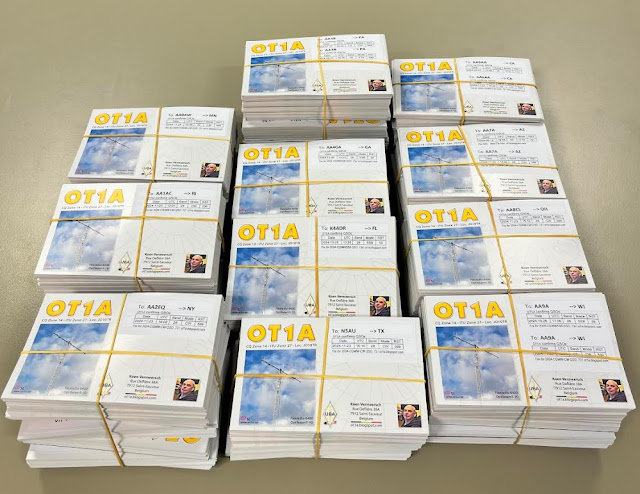Because a planned BBQ was canceled, I unexpectedly had some free time to participate in the European HF Championship. Getting the SteppIR up in the air was a bit too much work, as the boom plate (see previous post) still needs to be mounted. I wasn’t expecting any big results, so it was a good opportunity to run a few tests:
1. Test of the new 80-10m Windom antenna, bought during the recent sale at WIMO.
I already have sufficient experience with the 160-10m version, but since that antenna is over 80 meters long, installation takes quite a bit of effort. I purchased the smaller version so I could hang it on the north-south axis, as opposed to my G5RV which has to be hung east-west. The advantage of a Windom antenna is that it has a short leg (toward the house) and a long leg (toward the garden).
According to the manual, the antenna works on 80/40/30/20/17/10m—so not on 160m or 15m. On 160m, the analyzer showed an SWR between 1.7 and 2, and it was perfectly usable across the band. 15m indeed required more effort from the tuner, but it still managed to match it well enough for operation.
For this contest—where DX yields no points and the coverage area is very similar to the fieldday in the Restricted category—this was the ideal antenna.
The idea is also to test this antenna in the context of field days. That’s why I chose to hang it at “only” 14 meters (Field Day rules allow 15m) and to operate with a maximum of 100W (as prescribed by the Field Day regulations).
Log analysis indeed shows two nulls to the north and south, just as expected. However, the benefit now is that the northern null covers mostly water and very little land.
With 775 contacts across all bands, the result exceeded expectations.
This map, based on the ADIF file, has been created with "https://qsomap.cqgma.org/ADIF_to_Karte.php"
2. Test of the Flex6400 + PowerGenius + TunerGenius combo.
I was particularly interested in how this setup handles rapid band and segment switching, and whether the mandatory 20ms delay causes issues in CW—specifically, not hearing the first dit or dah.
Since I wanted to participate in the low power category, I set the drive power to just 1W. This resulted in output power ranging from 75W to 85W, depending on the band, which was sufficient. After all, I wouldn’t dare run a 100W transmitter at full power for hours straight during fieldday. On 160m, the output just exceeded 90W.
To configure the tuner, I went through all bands before the contest so the values would be saved in memory. During the contest, it felt as if there were no switching delays. This thing works perfectly.
The amp—still quite noisy even at minimal output—did throw a single SWR error. Cause unknown, but acceptable given it’s a wire antenna. However, it also completely froze once (a hard reset was required). That’s less acceptable. Sure, it all works over a LAN with various types of traffic, but that shouldn’t be a problem.
3. Test of N1MM+ in SO2V mode.
The configuration cost me a lot of time and frustration. I’ll write a separate article about it for future reference and to help others. In short, the FlexRadio6400 (and 8400) does not support SO2R since only one antenna port can be used (antenna ports A en B work like a switch) at a time. But 2 slices can be configured and they are able to receive simultaneously. However, N1MM+ must be configured as SO2R (not SO2V) because each of the two "slices" requires a separate COM port and is therefore treated by N1MM+ as two separate radios.
There were also the expected issues with using DAX and IQ streaming to feed the two skimmers and forward the output to N1MM+ (Telnet and port issues).
IQ streaming, in particular, caused problems—due to the SDR software—because the second stream sometimes wouldn’t start for no apparent reason. Power-cycling and restarting resolved the issue. This will be a focus for future contests: let the system run for hours beforehand so that nothing needs to be configured at the last minute.
The result, however, was fantastic—ideal for a wire antenna (or a tribander with a single coax).
Two bands were received simultaneously the entire time, and for the first few hours, I only did S&P. Running would likely yield more contacts, especially in the high power category, but even with just 80W, I could generate solid rates simply by clicking from station to station.
When enough red (multipliers) showed up on the second band, I could switch instantly and start again. This gives a massive strategic advantage in any assisted category. It's nothing like cluster input, because each skimmer signal was received on my own antenna and was instantly workable.
This is how you win Field Days with a minimum number of operators.
The contest itself was pleasantly busy, and I had enough time to configure the global layout on the screens.
Since I pushed through to the bitter end (2 AM is a real grind), there was no more competition left within ON. My neighbour, ON5JT, was a good competitor during the first hours of the contest, but then stopped operation at the evening. Our (few) signals were quite comparable.
My score will be somewhere in the top 25, not bad for an multiband wire antenna that isn't made for 15m.














































